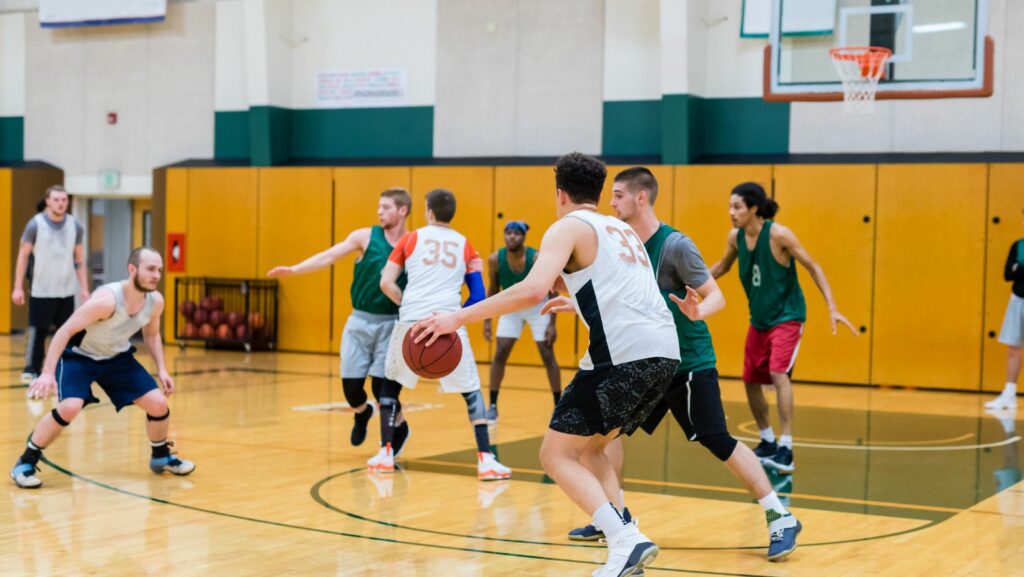College Basketball
- Cultural Phenomenon: College basketball is more than a sport; it unites fans and showcases the raw talent and passion of young athletes across the nation.
- Tournament Dynamics: The NCAA Tournament, or March Madness, features single-elimination games, creating an unpredictable and thrilling atmosphere that captivates millions of viewers.
- Coaching and Player Development: Successful college basketball programs rely on effective coaching strategies and continuous player development, impacting team performance and individual aspirations.
- Impact on Society: College basketball fosters community engagement through outreach programs and boosts local economies via job creation and tourism during events like the NCAA Tournament.
- Historic and Emerging Programs: Renowned programs like Duke and UCLA have significant legacies, while emerging teams like Gonzaga are reshaping the competitive landscape of college basketball.
College basketball captivates millions across the nation each season, showcasing the raw talent and unyielding passion of young athletes. With its thrilling games and intense rivalries, it’s more than just a sport; it’s a cultural phenomenon that unites fans from all walks of life. From the electrifying atmosphere of packed arenas to the nail-biting moments of March Madness, college basketball offers an experience unlike any other.
As teams battle for supremacy, they not only strive for glory but also shape the future of the sport. Coaches and players alike work tirelessly to develop skills and strategies, making each game a showcase of determination and teamwork. Whether it’s a last-second shot or a buzzer-beater victory, college basketball never fails to deliver unforgettable moments that keep fans on the edge of their seats.
Overview Of College Basketball
College basketball serves as a crucial part of American sports culture. It features universities and colleges across the nation competing for titles and recognition. Over 350 teams participate in Division I, as governed by the NCAA. Each season lasts from November through April, culminating in the NCAA Tournament, popularly known as March Madness.
March Madness attracts millions of viewers, showcasing intense matchups and thrilling upsets. The single-elimination format creates an atmosphere of unpredictability. Teams battle for the championship, making every game critical to success. Players often gain national attention, with some entering the NBA after their college careers.
Rivalries play a significant role in the landscape of college basketball. Classic matchups, such as Duke vs. North Carolina, enhance fan engagement and excitement. These games often impact ranking and tournament selection.
Coaching influences the development and performance of players. Coaches implement strategies and adjustments that prove vital during crucial moments. Programs with strong coaches often achieve consistent success.
Player skill development remains crucial in college basketball. Training routines and practice sessions refine techniques and teamwork. Players hone abilities, preparing for professional aspirations and enhancing their collegiate experience.
Overall, college basketball embodies determination, teamwork, and tradition, continuing to resonate with fans at every level.
History Of College Basketball
College basketball emerged in the late 19th century as a formalized sport, evolving rapidly to become an integral part of American sports culture.
Early Beginnings
College basketball traces its roots to 1891 when Dr. James Naismith, a physical education instructor, developed the game to engage students during winter. The first game utilized a soccer ball and two peach baskets as goals. By the turn of the century, various colleges began adopting the game, leading to the establishment of the first college tournament in 1906. The sport gained traction, with several institutions creating teams, rules, and leagues, shaping its early competitive nature.
Major Milestones
Key milestones significantly impacted the growth of college basketball:
| Year | Milestone |
|---|---|
| 1939 | The inaugural NCAA Tournament took place. |
| 1951 | The first televised college basketball game aired, broadening its audience. |
| 1973 | The NCAA introduced a women’s basketball championship. |
| 1982 | The NBA established a formal relationship with the NCAA, enhancing player visibility. |
| 1991 | The NCAA launched a major marketing campaign, further promoting March Madness. |
These milestones demonstrate the sport’s evolution, from local competitions to a nationally recognized spectacle, solidifying its status in American culture.
The Structure Of College Basketball
College basketball operates under a well-defined structure that includes the NCAA Divisions and various conference affiliations, which significantly shape the competitive landscape of the sport.
NCAA Divisions
The NCAA (National Collegiate Athletic Association) organizes college basketball into three primary divisions: Division I, Division II, and Division III.
- Division I: Consists of over 350 teams, featuring the highest level of competition. These schools typically offer athletic scholarships, allowing recruitment of top talent. The NCAA Tournament, known as March Madness, showcases the best teams in thrilling playoff matchups.
- Division II: Comprises around 300 institutions that balance athletics with academics. Schools in this division may offer partial scholarships but focus on overall student development and competition. Teams participate in conference tournaments and have a path to the NCAA Tournament.
- Division III: Includes more than 400 colleges and universities, emphasizing the student-athlete experience over athletic scholarships. These institutions prioritize academics, with no scholarships for athletics. The Division III NCAA Tournament promotes a competitive environment while maintaining student interest.
Conference Affiliations
College basketball teams belong to various conferences, creating divisions within the sport. Conferences are geographical or competitive groupings that facilitate scheduling and rivalry development.
- Power Five Conferences: The ACC, Big Ten, Big 12, Pac-12, and SEC host many of the nation’s elite programs. Teams compete at a high level, and their conference tournaments often impact NCAA Tournament seeding.
- Mid-Major Conferences: Includes conferences like the Atlantic 10 or Conference USA. Teams frequently compete for at-large bids in the NCAA Tournament, showcasing their talent against higher-ranked opponents.
- Lower-Level Conferences: Contain smaller institutions that compete for championships within their regions. Teams strive for success in conference tournaments, seeking an automatic bid to the NCAA Tournament.
Through these divisions and affiliations, college basketball fosters competition and strengthens rivalries, enriching the overall experience for players and fans alike.
Impact Of College Basketball On Society
College basketball significantly influences various aspects of society, from community engagement to economic development. The sport fosters a shared identity among fans, teams, and local communities, enhancing social dynamics.
Community Engagement
Community engagement in college basketball manifests through local events, charity initiatives, and youth programs. Schools often organize outreach activities, connecting players with students and residents.
- Outreach Events: Programs like basketball clinics help introduce the sport to youth, building skills and encouraging participation.
- Fundraising Campaigns: Many teams engage in fundraising efforts for local charities, increasing visibility and support for community organizations.
- School Spirit: College games often serve as community gatherings, fostering school pride and a sense of belonging among students and alumni.
These activities create stronger community bonds and promote a culture of teamwork and mutual support.
Economic Influence
College basketball also drives economic influence at local and national levels. The sport generates significant revenue through ticket sales, merchandise, and broadcasting rights.
- Job Creation: Events create jobs in hospitality, security, and event management, boosting local employment rates.
- Tourism Revenue: The NCAA Tournament attracts visitors, enhancing local economies through increased spending on hotels, restaurants, and attractions.
- Sponsorship Deals: Partnerships with corporations contribute to funding for athletic programs, elevating the financial status of institutions.
The economic benefits of college basketball extend beyond the court, enhancing local businesses and providing resources for academic and athletic development.
Notable College Basketball Programs
College basketball features numerous programs with rich histories and promising futures. These programs not only contribute to the competitive landscape but also shape the culture of the sport.
Historic Powerhouses
Historic powerhouses dominate college basketball’s narrative, showcasing long-standing traditions and consistent successes.
- Duke University: Known for its elite coaching under Mike Krzyzewski, Duke boasts five NCAA Championships. The team’s intense rivalries, particularly with North Carolina, fuel fan engagement.
- University of North Carolina: Another dynasty, UNC has won six NCAA titles. The Tar Heels’ rich history includes legendary players like Michael Jordan, emphasizing their cultural impact.
- UCLA: With a record 11 NCAA Championships, UCLA remains a symbol of dominance. Legendary coach John Wooden’s legacy continues to resonate within college basketball.
- Kentucky: Kentucky stands out with eight NCAA Championships. The program’s commitment to excellence nurtures numerous NBA players, reinforcing its historic status.
- Indiana University: Known for its passionate fanbase, Indiana claims five NCAA Championships. The program’s rich tradition and success have solidified its legacy in the sport.
Emerging Programs
Emerging programs signify the evolution of college basketball, showcasing potential and ambition.
- Gonzaga University: Once a mid-major, Gonzaga has consistently reached the NCAA Tournament. The Bulldogs’ strong recruiting and coaching strategies have led to national prominence.

- Marquette University: Marquette, with a history of solid performance, aims for resurgence in the national spotlight. Recent successes strengthen its competitive stature.
- Loyola Chicago: Known for its Cinderella run in 2018, Loyola Chicago captured attention with a strong tournament presence. The program’s continued development signals future competitiveness.
- University of Houston: Houston has transitioned into a formidable contender, reaching the NCAA Tournament’s later stages. The Cougars’ effective recruitment and coaching enhance their playoff ambitions.
- Seton Hall University: Seton Hall aims for national recognition, consistently competing in tough conferences. The Pirates’ dedication to improving their program underscores their potential growth trajectory.
Essence of Beloved Sport
College basketball stands as a vibrant and essential part of American sports culture. Its thrilling games and passionate rivalries create a unique atmosphere that captivates fans nationwide. The dedication of players and coaches fosters unforgettable moments that resonate deeply within communities.
As the sport continues to evolve, it remains a powerful force for engagement and economic growth. The blend of tradition and innovation ensures that college basketball will not only endure but thrive in the hearts of fans for generations to come. With every season, the excitement builds, promising new stories and unforgettable experiences that define the essence of this beloved sport.

